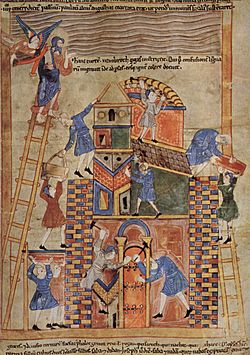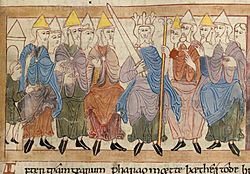Old English Hexateuch facts for kids

The Old English Hexateuch is the collaborative project of the late Anglo-Saxon period that translated the six books of the Hexateuch into Old English, presumably under the editorship of Ælfric of Eynsham. It is the first English vernacular translation of the first six books of the Old Testament, i.e. the five books of the Torah (Genesis, Exodus, Leviticus, Numbers and Deuteronomy) and Joshua. It was probably made for use by lay people.
The translation is known in seven manuscripts, most of which are fragmentary. The best-known of those is a richly illuminated manuscript in the British Library, Cotton MS Claudius B.iv. Another copy of the text, without lavish illustrations but including a translation of the Book of Judges (hence also called the Old English Heptateuch), is found in Oxford, Bodleian Library, Laud Misc. 509.
The whole manuscript is available online at the British Library website.
Cotton Claudius B.iv, British Library
Claudius B.iv. was probably compiled in the second quarter of the 11th century at St Augustine's Abbey, Canterbury. It incorporates translations and a preface by Ælfric of Eynsham, while the remaining parts of the translation were carried out by anonymous authors. Peter Clemoes suggests that Byrhtferth of Ramsey was responsible for the compilation as well as for parts of the translation. With 156 folios, it is largely complete, but does not include all the biblical text of the books. Commentary and other material in Latin and Old English was added in the 12th century, often using blank areas in incomplete miniatures.
One or, more likely, several artists accompanied the narrative with 394 drawings in inks of various colours, most brightly coloured with washes, containing about 550 scenes. Many of these are unfinished, at varying stages of completion. The settings do not attempt to represent Old Testament life as anything different from that of contemporary Anglo-Saxons, and so give valuable depictions of many aspects of the Anglo-Saxon world. The extensive illustrations suggest that it was designed mainly for lay use. It is the earliest illustrated manuscript of a large part of the bible in any vernacular language.
There are twelve full-page miniatures spread through the texts, and the other miniatures range from nearly full-page to about a quarter of a page. Many pages have two or even three illustrations, and the majority of pages have a miniature, some of which combine two scenes in bordered compartments. The degree of completion with washes tends to diminish as the book goes on. The colouring has some eccentricities; in particular many figures have blue hair, and the many tents are shown with boldly coloured stripes. Opportunities offered by the text to show groups of animals are usually taken, and the Hand of God frequently appears. The sheet size is 325 by 215 millimetres (12.8 in × 8.5 in) , with the text occupying 260 by 160 millimetres (10.2 in × 6.3 in). It was in the Cotton Library by 1621.
See also
- Wessex Gospels


